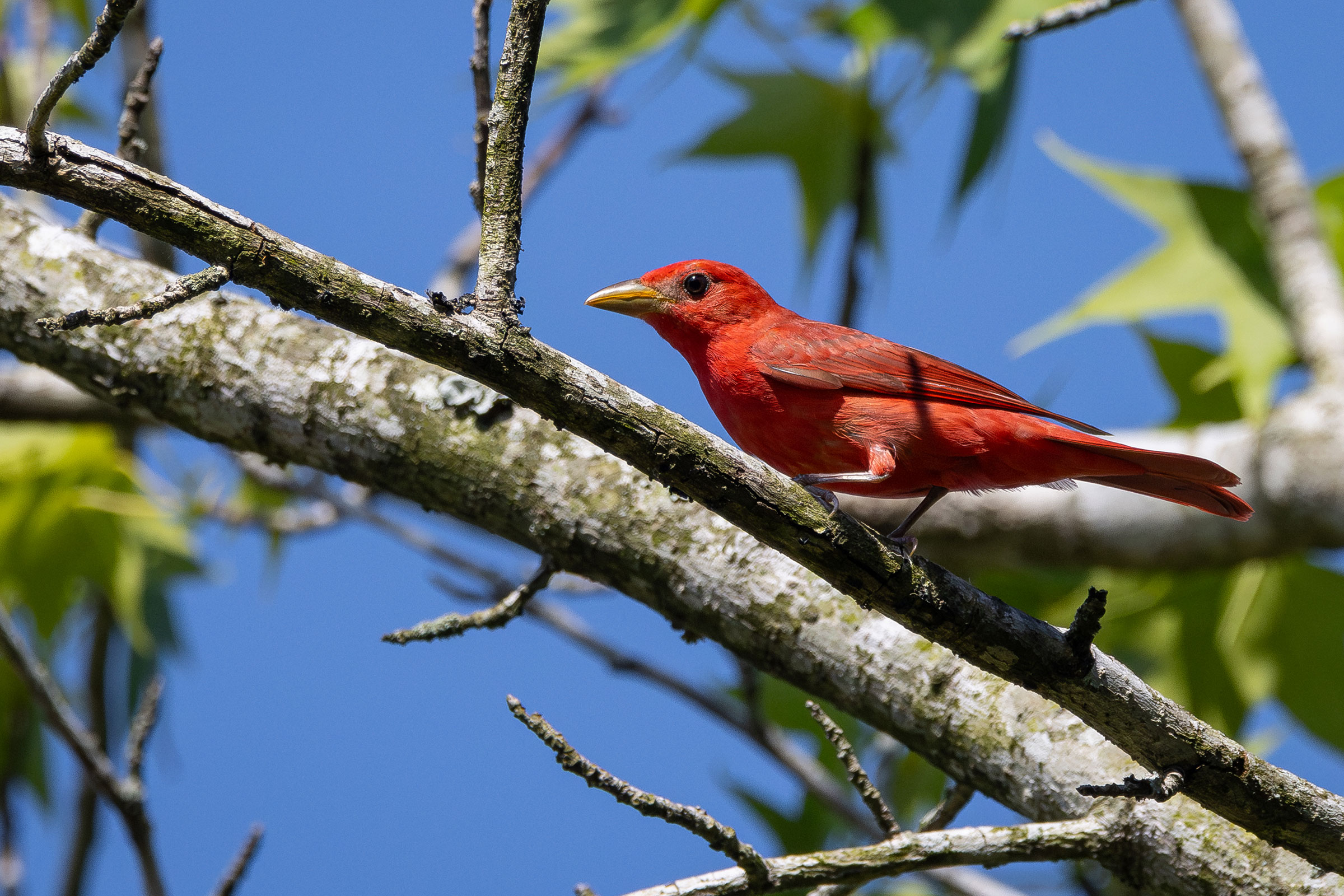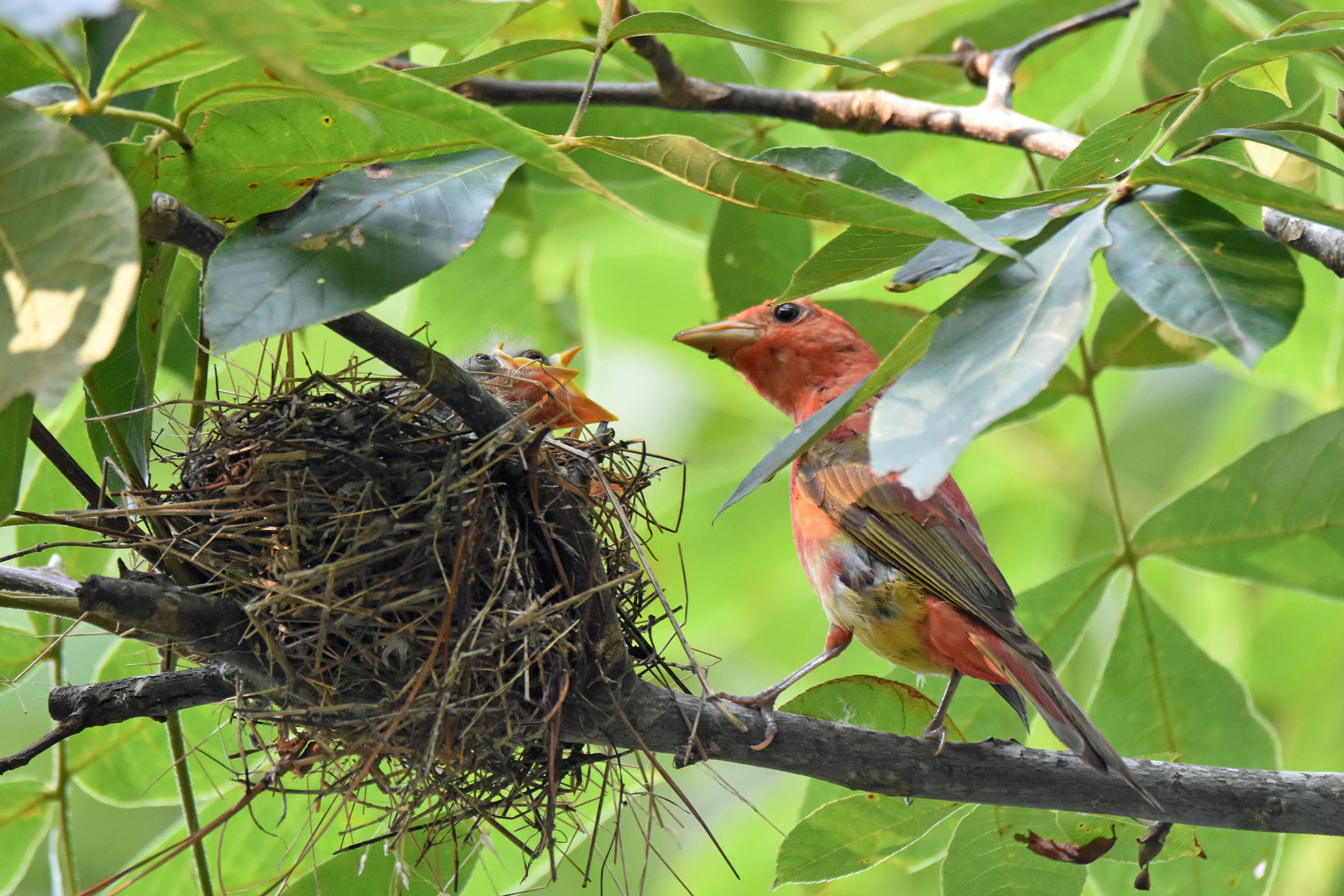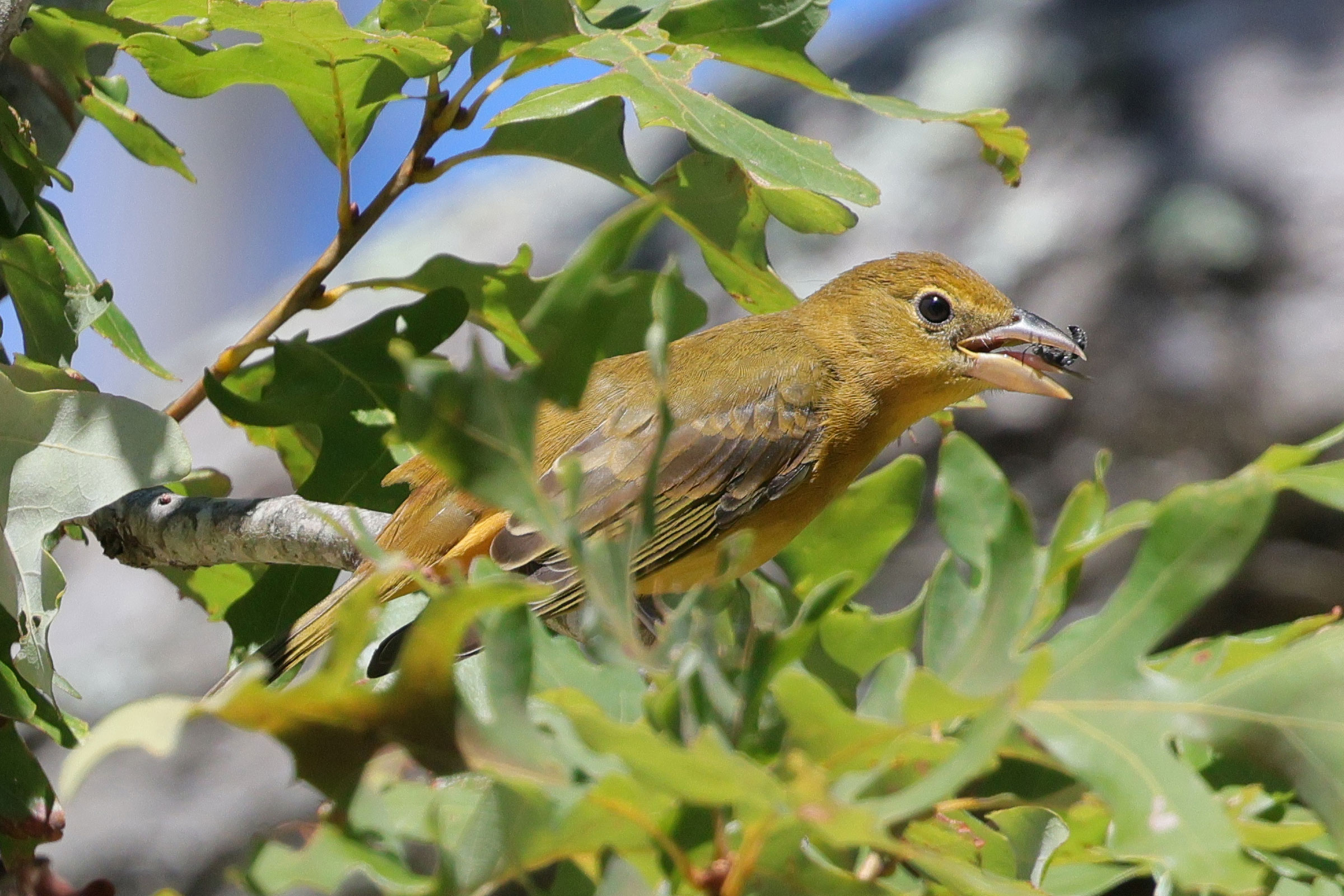Introduction
Within Virginia, the stunning, all red Summer Tanager breeds almost exclusively in the Piedmont and Coastal Plain regions. Summer Tanagers nest in gaps and at the edges of open deciduous or pine-oak forests, even in longleaf pine (Pinus palustris) ecosystems further south, where males sing a slurred whistle that sounds somewhat like an American Robin (Turdus migratorius) song. The yellow female is difficult to see amid the green leaves of the forest canopy (Robinson 2020).
Breeding Distribution
While the Summer Tanager sometimes occurs in the Mountains and Valleys region, observations from that region were too few to support development of an occupancy model. Within the Piedmont and Coastal Plain regions, the species is highly likely to occur in most areas, except in heavily urbanized areas, such as Norfolk, Northern Virginia, and Richmond (Figure 1). Its likelihood of occurring increases as the amount of grassland, shrubland, and forest edge habitats and the number of habitat types increase in a block, while it decreases as the amount agricultural land and developed areas increases.
Between the First and Second Atlases (Figures 1 and 2), the Summer Tanager’s probable occurrence decreased in highly urbanized areas in the Piedmont region, especially in Northern Virginia (Figure 3). In contrast, its likely occurrence increased in the southeastern corner of the Coastal Plain and on the Eastern Shore.
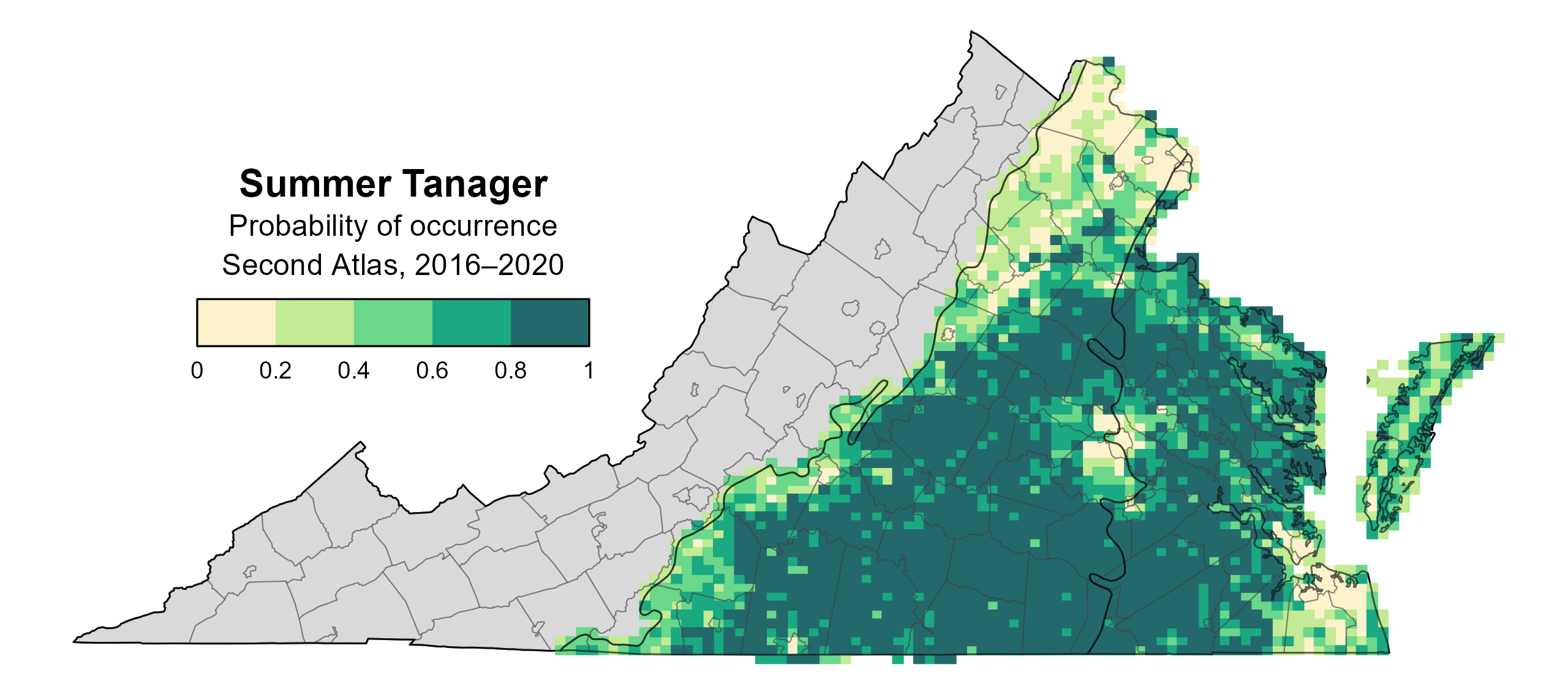
Figure 1: Summer Tanager breeding distribution based on probability of occurrence (Second Atlas, 2016–2020). This map indicates the probability that this species will occur in an Atlas block (an approximately 10 mi2 [26 km2] survey unit) based on environmental (including habitat) factors and after adjusting for the probability of detection (variation in survey effort among blocks). Blocks in gray are outside the species’ core range and were not modeled.
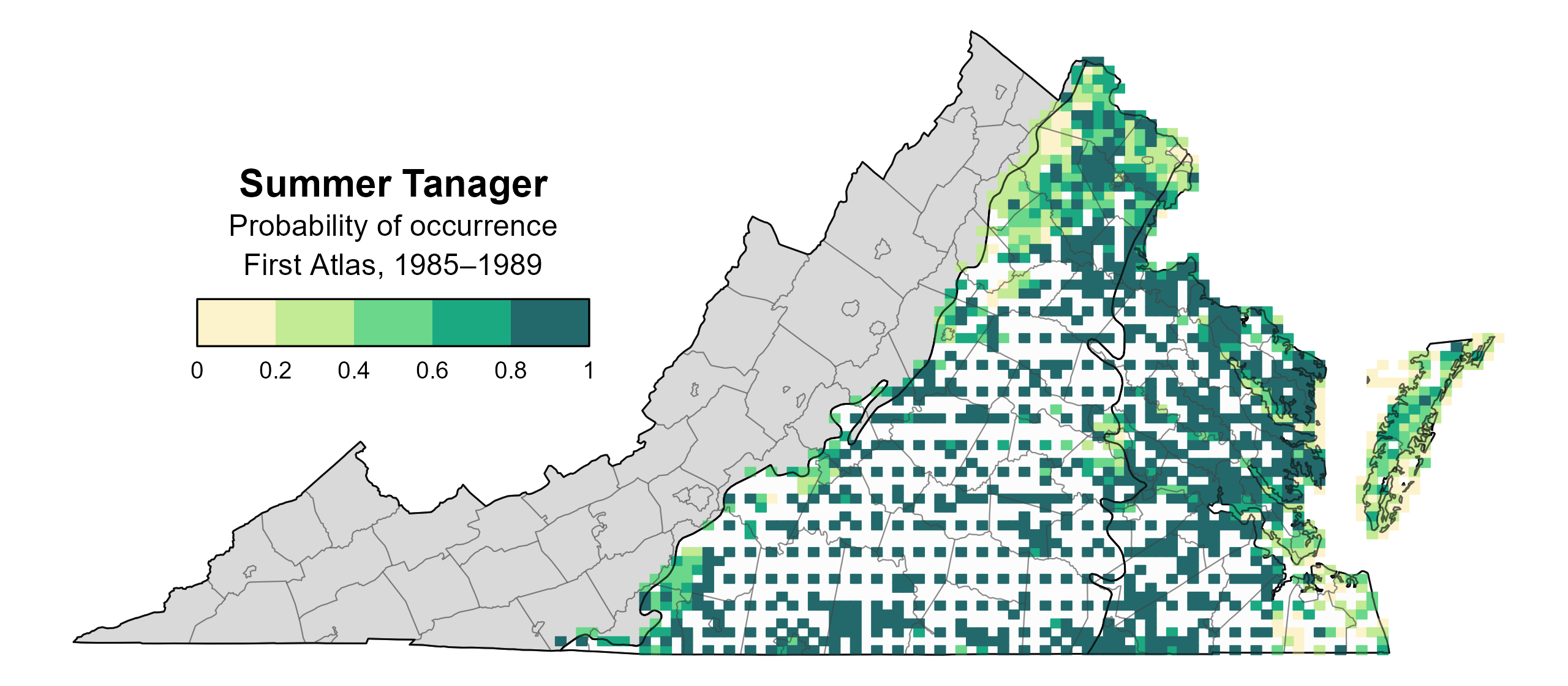
Figure 2: Summer Tanager breeding distribution based on probability of occurrence (First Atlas, 1985–1989). This map indicates the probability that this species will occur in an Atlas block (an approximately 10 mi2 [26 km2] survey unit) based on environmental (including habitat) factors and after adjusting for the probability of detection (variation in survey effort among blocks). Blocks in white were not surveyed during the First Atlas and were not modeled. Blocks in gray are outside the species’ core range and were not modeled.
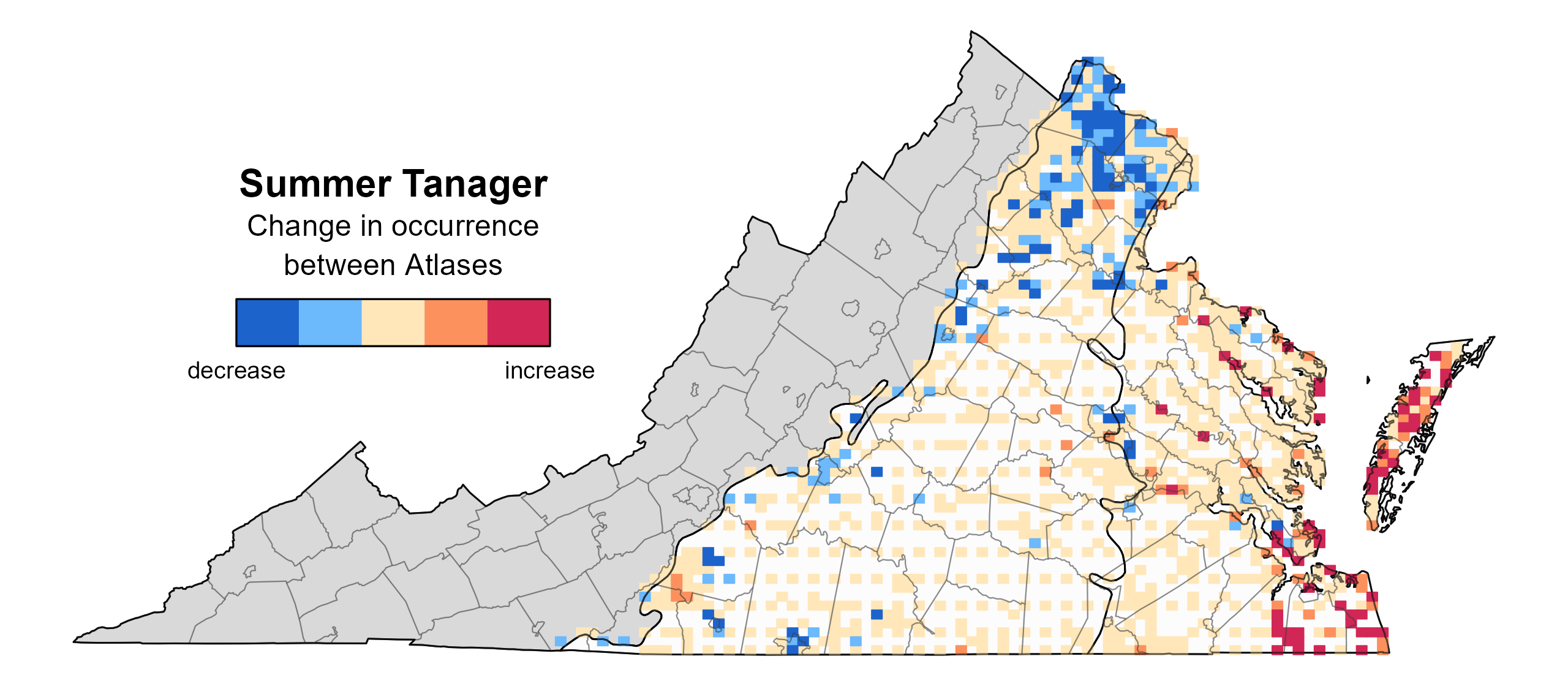
Figure 3: Summer Tanager change in breeding distribution between Atlases (1985–1989 and 2016–2020) based on probability of occurrence. This map indicates the change in the probability that this species will occur in a block (an approximately 10 mi2 [26 km2] survey unit) between Atlas periods. Blocks with no change (tan) may have constant presence or constant absence. Blocks in white were not surveyed during the First Atlas and were not modeled. Blocks in gray are outside the species’ core range and were not modeled.
Breeding Evidence
Summer Tanagers were confirmed breeders in 128 blocks and 54 counties and probable breeders in 16 additional counties (Figure 4). Most breeding observations were recorded within the Piedmont and Coastal Plain regions; however, a few detections occurred within the Mountains and Valleys region. A similar distribution of observations were observed during the First Atlas within the Piedmont and Coastal Plain regions, but more observations were documented in the Mountains and Valleys region, especially in the southwestern corner (Figure 5).
The earliest confirmed breeding behavior was recorded at the end of April when adults were observed carrying nesting material (Figure 6). Other breeding behaviors included observations of adults carrying food (May 11 – July 26), recently fledged young (May 17 – August 10), and adults feeding young (June 4 – August 14) (Figure 6).
For more general information on the breeding habits of this species, please refer to All About Birds.

Figure 4: Summer Tanager breeding observations from the Second Atlas (2016–2020). The colored boxes illustrate Atlas blocks (approximately 10 mi2 [26 km2] survey units) where the species was detected. The colors show the highest breeding category recorded in a block. The numbers within the colors in the legend correspond to the number of blocks with that breeding evidence category.
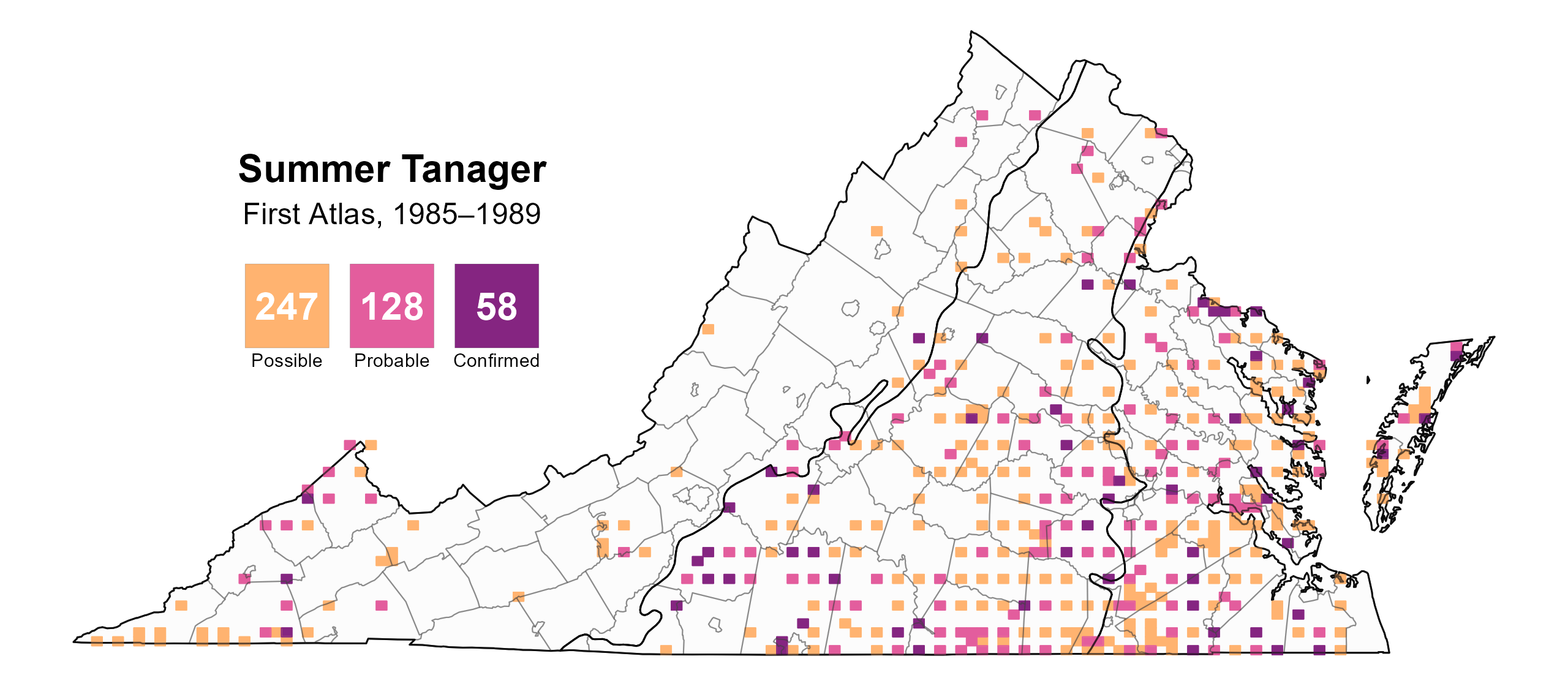
Figure 5: Summer Tanager breeding observations from the First Atlas (1985–1989). The colored boxes illustrate Atlas blocks (approximately 10 mi2 [26 km2] survey units) where the species was detected. The colors show the highest breeding category recorded in a block. The numbers within the colors in the legend correspond to the number of blocks with that breeding evidence category.
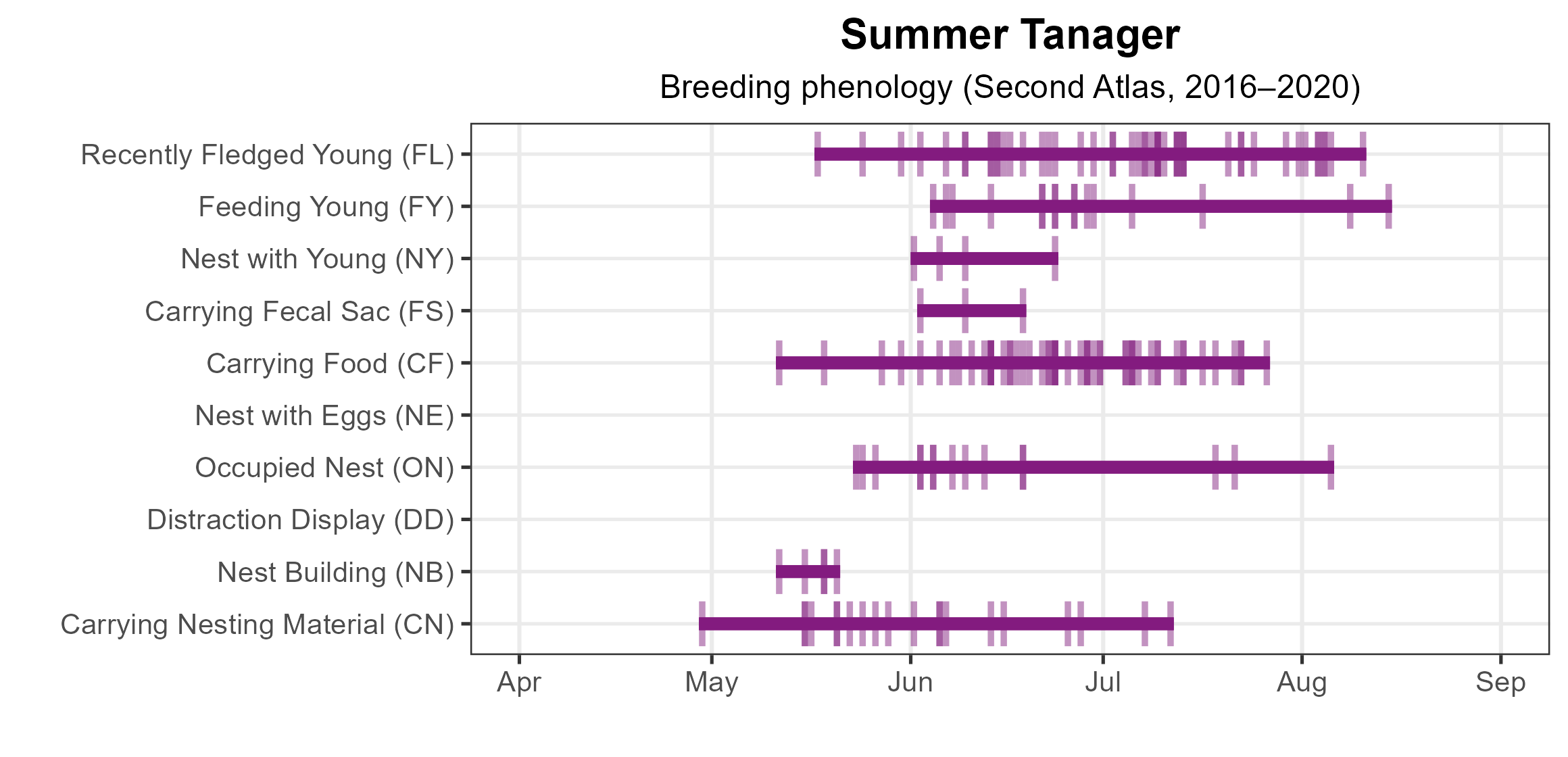
Figure 6: Summer Tanager phenology: confirmed breeding codes. This graph shows a timeline of confirmed breeding behaviors. Tick marks represent individual observations of the behavior.
Population Status
Summer Tanager relative abundance was estimated to be high throughout much of the Coastal Plain region and in the southeastern portion of the Piedmont region (Figure 7). Lower abundance was predicted for highly developed areas.
The total estimated Summer Tanager population in the state is approximately 396,000 individuals (with a range between 279,000 and 566,000). Based on the North American Breeding Bird Survey (BBS), the Summer Tanager population experienced a nonsignificant increase of 0.75% annually from 1966–2022 in Virginia, and between Atlas periods, it showed a similar nonsignificant increase of 0.97% per year from 1987–2018 (Hostetler et al. 2023; Figure 8).
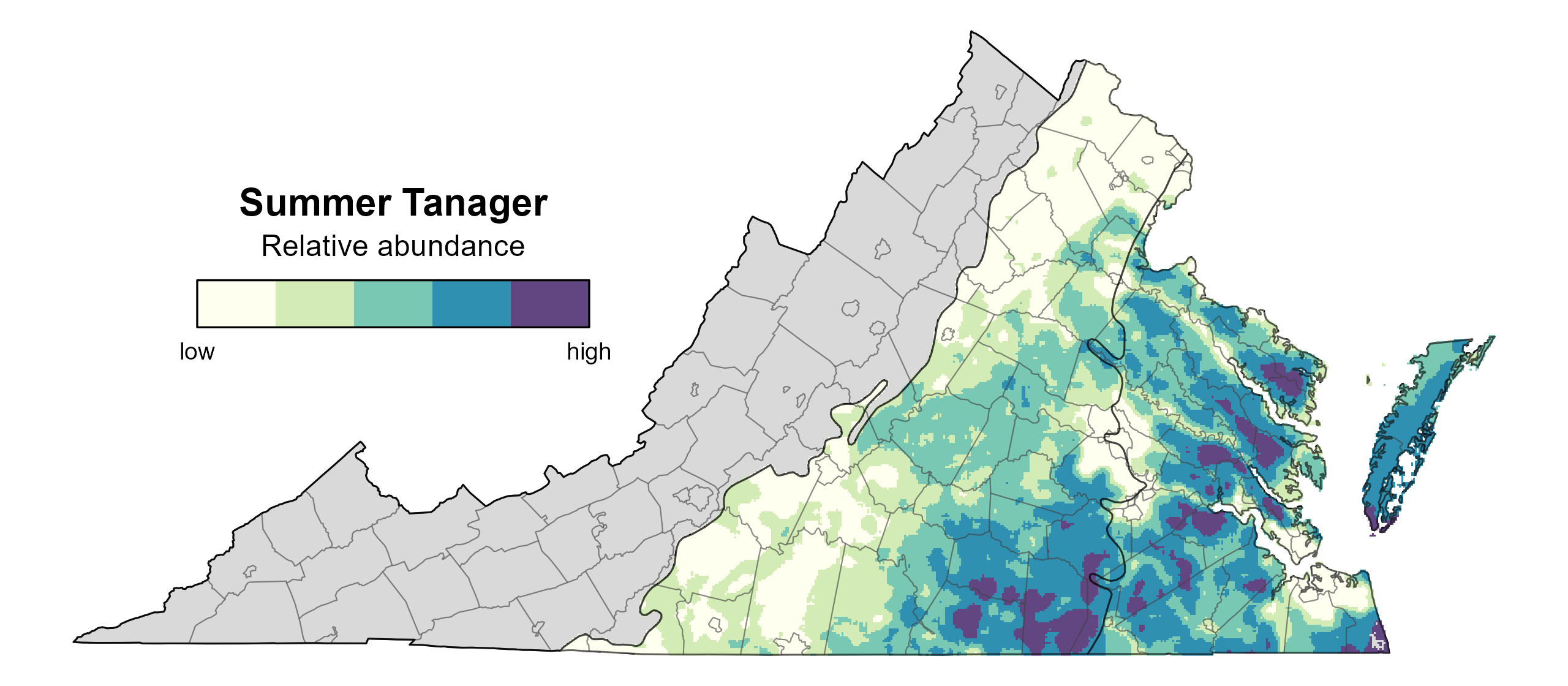
Figure 7: Summer Tanager relative abundance (Second Atlas, 2016–2020). This map indicates the predicted abundance of this species at a 0.4 mi2 (1 km2) scale based on environmental (including habitat) factors. Abundance values are presented on a relative scale of low to high. Areas in gray are outside the species’ core range and were not modeled.
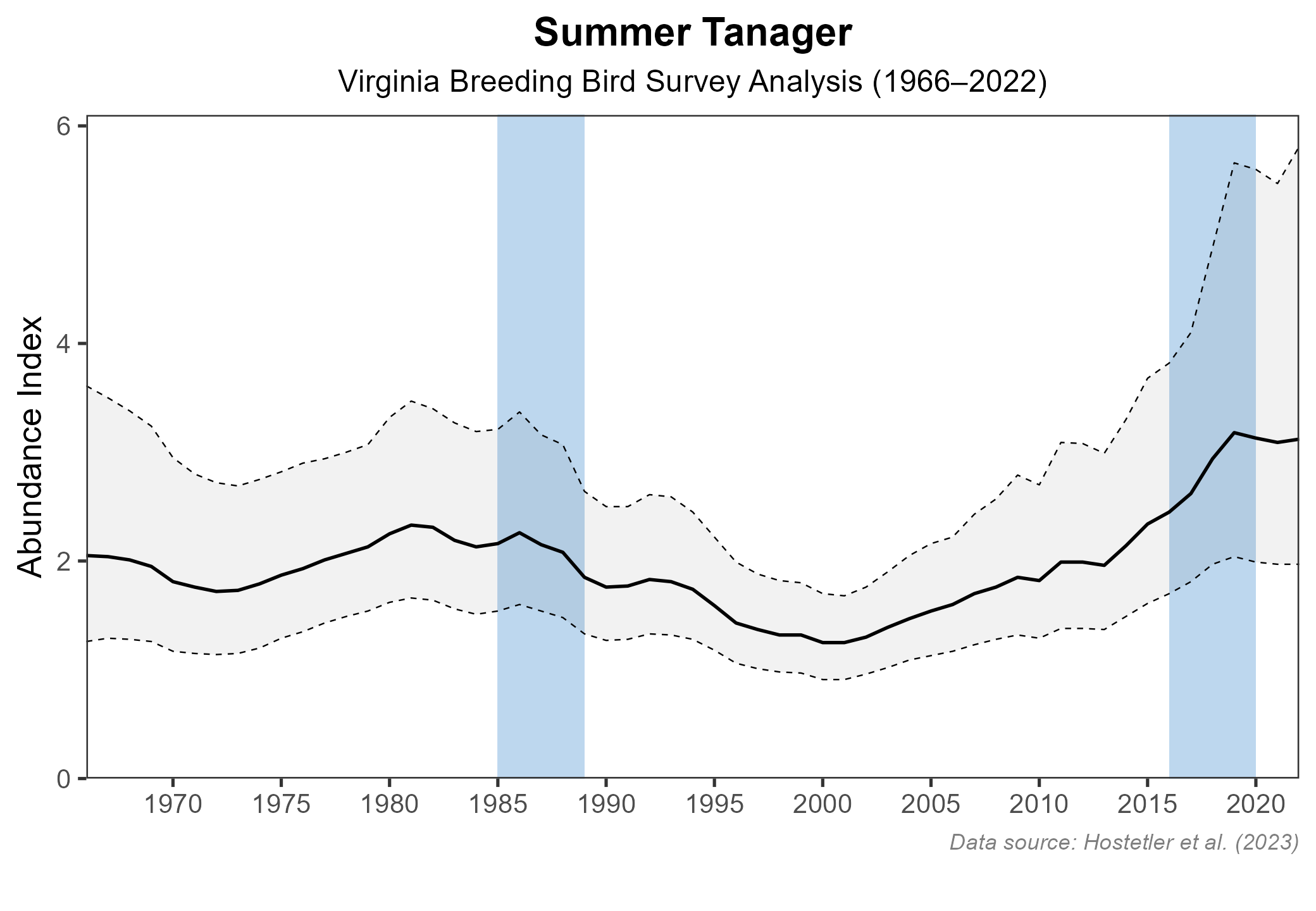
Figure 8: Summer Tanager population trend for Virginia as estimated by the North American Breeding Bird Survey. The vertical axis shows species abundance; the horizontal axis shows the year. The solid line indicates the estimated population trend; there is a 97.5% probability that the true population trend falls between the dashed lines. The shaded bars indicate the First and Second Atlas periods.
Conservation
The Summer Tanager is common and widespread throughout Virginia and its range (Ritchison et al. 2020). They are not considered a species of special concern, and no specific conservation projects are underway in Virginia (Robinson 2020).
Interactive Map
The interactive map contains up to six Atlas layers (probability of occurrence for the First and Second Atlases, change in probability of occurrence between Atlases, breeding evidence for the First and Second Atlases, and abundance for the Second Atlas) that can be viewed one at a time. To view an Atlas map layer, mouse over the layer box in the upper left. County lines and physiographic regional boundaries (Mountains and Valleys, Piedmont, and Coastal Plain) can be turned on and off by checking or unchecking the box below the layer box. Within the map window, users can hover on a block to see its value for each layer and pan and zoom to see roads, towns, and other features of interest that are visible beneath a selected layer.
View Interactive Map in Full Screen
References
Hostetler, J. A., J. R. Sauer, J. E. Hines, D. Ziolkowski, and M. Lutmerding (2023). The North American breeding bird survey, analysis results 1966–2022. U.S. Geological Survey, Laurel, MD, USA. https://doi.org/10.5066/P9SC7T11.
Robinson, W. D. (2020). Summer Tanager (Piranga rubra), version 1.0. In Birds of the World (A. F. Poole, Editor). Cornell Lab of Ornithology, Ithaca, NY, USA. https://doi.org/10.2173/bow.sumtan.01.

